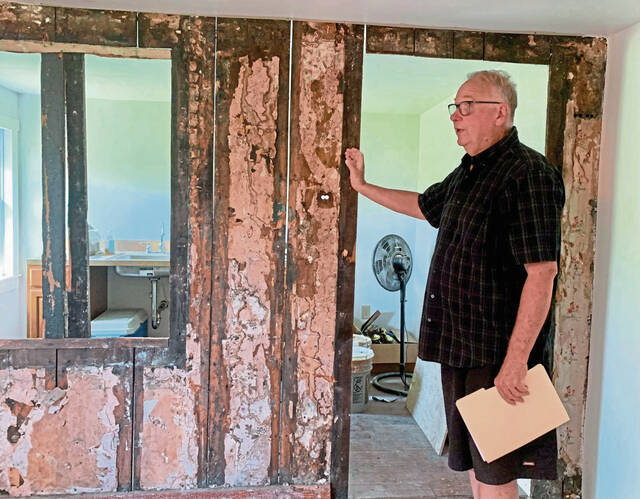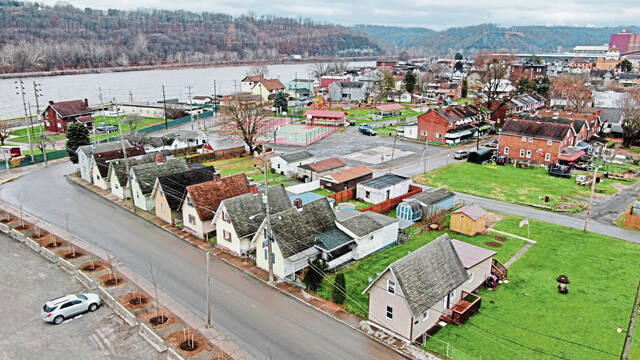Penn Salt Museum will give visitors glimpse into Natrona's historic significance
Polish immigrants Stanley and Josephine Lapczynski arrived in the Natrona section of Harrison before the turn of the 20th century and settled into a cottage at 34 Federal St.
The couple raised six children in the four-room house owned by Penn Salt Manufacturing Co., which abutted the Allegheny River and produced chemicals for home and industrial use.
Seven decades after the plant closed in the 1940s, the abandoned house was purchased by the Natrona Comes Together Association in hopes of transforming it into a public museum.
“If these walls could talk, huh?” said Bill Godfrey, president of the nonprofit group spearheading the preservation.
Godfrey and other volunteers have ramped up efforts to open the restored facility, recently hanging a sign to mark the building and also forming a committee to move forward with potential events.
“When we say museum, we are talking more about an educational classroom,” Godfrey said.
“We want to develop a curriculum, but we have a very small space. We don’t want to crowd it with mementos; rather, we want to give people a glimpse into the rich history and use it to propel our future.”
The purchase in 2012 was assisted by the Pittsburgh History and Landmarks Foundation, which helped to restore the 1½-story Gothic Revival home.
Situated among “Pigeon’s Row,” the board and batten cottage was one of 16 homes along Federal Street that were the first to be constructed by Penn Salt. A similar row sat across the street but was demolished when the property was purchased by Allegheny Ludlum, now ATI.
“This museum will be a walk down memory lane for those of us who were born and raised in Natrona,” said Patty Babinsack, a founding member of Natrona Comes Together. “You remember all this stuff from when it was a booming town.”
Founded in 1850 in an area rich with salt brine wells, Penn Salt played a large role in war material production from the Civil War through World War II.
It was listed on a Nazi hit list because the plant processed cryolite, used in aluminum production for war planes, and produced hydrofluoric acid, used to make high-octane aviation gasoline and aerosol bombs, Godfrey said.
Throughout the years, Penn Salt created an insulated hub for its workers through the construction of 150 wood and brick homes surrounding the industrial factories.
Employees were paid with Penn Salt dollars that were used for rent and groceries in the company store.
Some of the mansions that line the railroad tracks belonged to foremen, but, otherwise, everyone rented a company house.
“In other words, all of the money went back into the company,” Godfrey said.
David Farkas, History and Landmarks Foundation director of real estate development, said the museum is within the Penn Salt Historic District, an area listed on the National Register of Historic Places.
Company homes along Federal Street were identical in dimensions and design.
The main floor of each house measured only about 14-by-30 feet and was served by a central chimney. They have steep sloped roofs and side entrances, and the similar appearances created a cohesive streetscape.
Funding acquired with help from the late state Sen. Jim Ferlo, and the History and Landmarks Foundation allowed crews to construct a more accessible entrance with a ramp and railings.
Godfrey said new windows and a wheelchair-accessible restroom were installed.
“We’ve spent thousands of hours restoring it,” he said.
“One of the back walls, we pushed over with our hands. We found out the place was at one point covered with asbestos siding. We had a lot to do.”
Godfrey and others believe Penn Salt is a vital piece of American history. The factory changed the world in both good ways and bad, he said.
“In 1939, they came up with DDT,” he said. “But it was also the beginning of the environmental movement after the company was found to be throwing waste into the river.”
The chance to salvage an original company home was invaluable, Godfrey said.
Babinsack hopes the museum will spur further revitalization in Natrona.
“This was a great town, and then all the businesses went up the hill,” she said. “I feel, in due time, it will come back around.”
Anyone interested in volunteering can email Godfrey at bill@billbanner.com.
Tawnya Panizzi is a TribLive reporter. She joined the Trib in 1997. She can be reached at tpanizzi@triblive.com.
Remove the ads from your TribLIVE reading experience but still support the journalists who create the content with TribLIVE Ad-Free.




